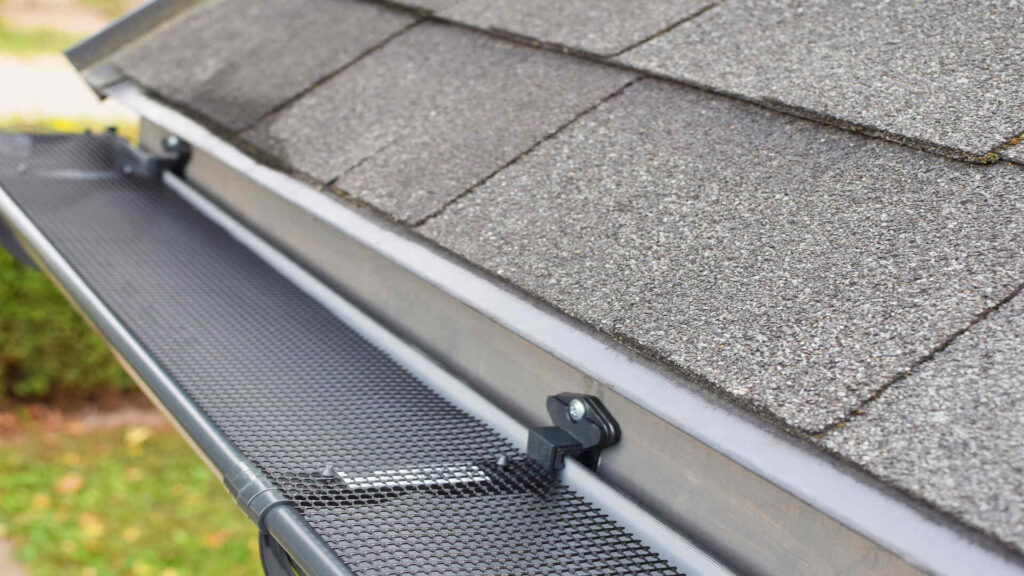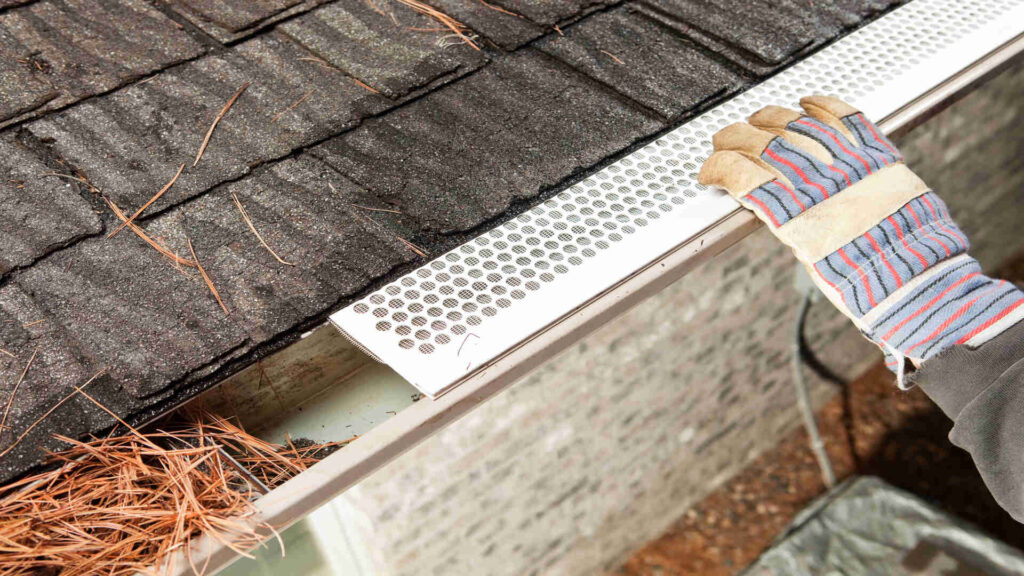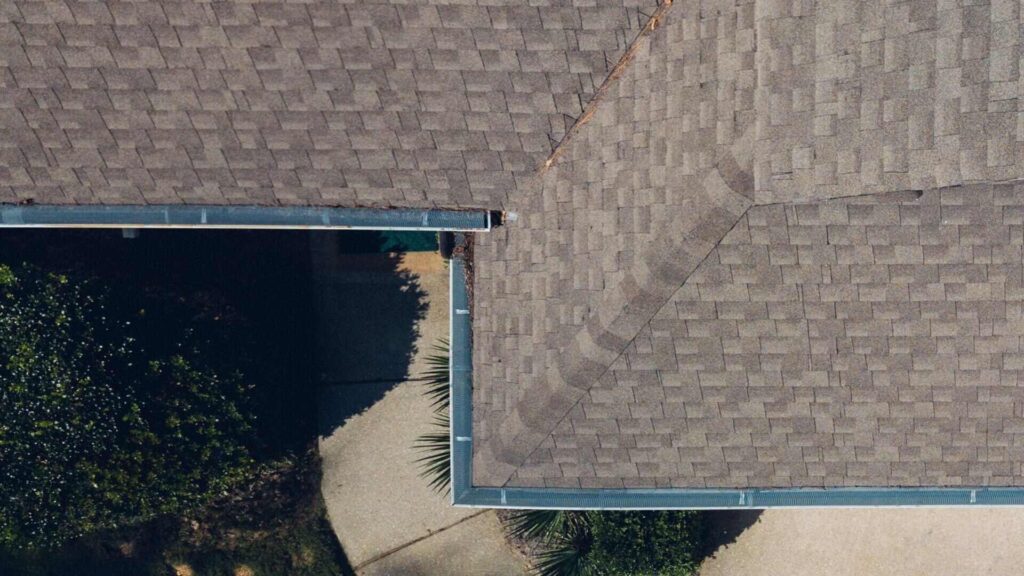Install gutter guards in New Jersey with safety first. Assess gutters, choose suitable guards, clean and trim gutters, position and secure guards correctly, and perform regular maintenance.

Table of contents
What is a Gutter Guard?
A gutter guard is a protective covering designed to shield a rain gutter from unwanted debris, preventing clogs and ensuring the free flow of water away from a structure.
These are important in maintaining the health and functionality of your gutters, as they reduce the frequency of cleaning and potential damage from backed-up water.
Importance of Gutter Guards
Gutter guards keep gutters clean. They help prevent leaves and debris from blocking the way, ensuring rainwater drains right. It shields a home’s foundation, walls, and roof.
In cold months, they help stop ice buildup on roofs. They also keep birds, bugs, and pests from nesting. With them, homeowners have less cleaning and save on costly gutter repairs. They’re a smart way to protect homes.
Safety Precautions & Tips
When installing gutter guards, always prioritize your safety. Always use a strong ladder and have someone help by holding it for you.
Wear gloves to protect your hands and safety glasses for your eyes. Watch out for things like power lines or tree branches. And don’t rush. Take your time to do the job right and safely.
Disclaimer: Always consult gutter professionals before making any home improvements. The advice provided here is for informational purposes only.
Tools and Materials Needed
You’ll require some tools and materials for the job. Here’s a checklist:
- Gutter guards – These are the main pieces you’ll install.
- Ladder – To reach your gutters safely.
- Gloves – To protect your hands while working.
- Hose with spray nozzle – For cleaning the gutters before installing.
- Bucket – To collect debris from the gutters.
- Tape measure – To make sure the gutter guards fit right.
- Tin snips or scissors – For cutting the gutter guards if needed.
- Screwdriver or drill – Some gutter guards might need screws to stay in place.
Guide to Setting Up Gutter Guards
Putting in gutter guards is a good idea. They prevent leaves from clogging your gutters, allowing rainwater to drain smoothly. It helps keep your home safe from water damage. This guide will show you how to put them on right.
Assess and Prepare
Begin by closely examining your gutters. Inspect for any cracks, holes, or signs of sagging. Identifying these issues is crucial, as they can lead to problems in the future.
If you encounter some issues, consider contacting a gutter professional for repairs or replacements. Also, ensure your gutters are firmly secured to maintain a stable foundation.
Measure
Using a tape measure, carefully determine the total length of your gutters around your home. Also, measure their width. This information is necessary because it helps you estimate how much guard material you should buy. It’s better to purchase extra material than your measurements suggest to account for potential errors or changes.
Select the Right Gutter Guards
Given New Jersey’s varying weather conditions of heavy rain and snow, it’s essential to have gutter guards that manage both situations effectively. They should be sturdy and well-designed. Choosing brands like Leaf Shelter and MicroGuard is the best choice. To keep away debris while allowing water to flow freely.
Clean Your Gutters

Before putting on the guards, clean your gutters well. Using a brush or a garden hose can help in cleaning hard-to-reach areas. After cleaning, let it fully dry before adding the guards. Dry gutters help the guards fit better and make the installation easier.
Trim the Guards
Using the measurements you obtained earlier, carefully cut the gutter guards to the appropriate length. It’s advisable to leave some extra length when trimming to ensure a precise and snug fit. This extra precaution will help optimize the performance of your gutter guards.
Position the Guards

Regardless of your roof type, always ensure that the gutter guards sit flush against the gutter’s edge to prevent debris from slipping through any gaps. Proper installation tailored to your specific roof type will help maintain the cleanliness and functionality of your gutters in New Jersey’s varied weather conditions.
- Metal Roofs: For metal roofs, it’s advisable to slide the gutter guards under the metal roof. This method ensures a snug fit and prevents debris from entering the gutters. Be cautious when securing the guards so as not to damage the metal roof’s surface.
- Asphalt Roofs: Asphalt shingle roofs are common in New Jersey. To install gutter guards on these roofs, slide them under the first row of shingles. This method provides effective protection against debris while maintaining the integrity of the shingles.
Fixing the Guards in Place
Gutter guards typically come with clips or screws to secure them firmly in position. It’s important to attach them tightly to ensure they remain secure and withstand the varying weather conditions of New Jersey. Be thorough in fastening them to maintain their effectiveness over time.
Inspect and Test
Review your work for any loose sections or gaps upon completing the installation. After installation, pour water into the gutter and observe its flow. This step helps ensure that rainwater drains freely without any blockages or standing water, maintaining the effectiveness of your gutter guards.
Options to Avoid
In New Jersey, gutters face varied weather conditions. While gutter guards offer benefits, not all types are compatible with this region. It’s important to know which ones might not be the best fit.
- DIY Kits with Inferior Materials: Often can’t handle New Jersey’s climate and may break easily.
- Non-Covering Strainers: Only cover downspouts, allowing debris to accumulate on top.
- Vinyl Guards: These can become brittle when the weather is cold and sag in warmth, making them less suitable for regions with fluctuating climate conditions.
- One-Size-Fits-All Solutions: Generic solutions can lead to poor fits and reduced efficiency.
- Gutter Screens with Large Openings: Small debris like pine needles can easily pass through, leading to clogs.
- Low-Cost Installations: Suspiciously cheap offers might compromise on quality and installation standards.
- Disregarding HOA Guidelines: When installing gutter guards in New Jersey, consider checking local weather and regulations. Choose guards suitable for the climate, and be aware of municipal codes, environmental concerns, and HOA rules if applicable.
Maintaining Your Gutter Guards in New Jersey’s Seasons

In New Jersey, the shifting seasons present challenges for homeowners, especially when maintaining gutter guards. As the weather changes, the requirements for care and maintenance evolve.
- Fall: This season sees a significant amount of rainfall. Even with guards, check frequently and brush off accumulated leaves to ensure water flows freely.
- Winter: Snow and ice can weigh down or freeze over guards. Periodically inspect them and gently tap them to break off any ice buildup. If snow accumulates, consider brushing off excess to prevent weight strain.
- Summer: In the summer, storms, and wind can blow twigs and leaves onto your roof. Periodically check if your guards have trapped larger debris and remove them if necessary.
- Spring: As trees shed flowers and seed pods, ensure your guards are free from these potential blockages. A quick rinse with a garden hose can help clear them off.
Conclusion
In conclusion, gutter guards are essential for safeguarding your New Jersey home from the ever-changing weather. They keep your gutters clean, preventing water damage and reducing maintenance. Prioritize safety during installation, follow local rules, and get professional help when needed.
In summary, assess, measure, and choose the suitable gutter guards. Ensure a thorough cleaning and correct installation, followed by routine seasonal upkeep. Stay informed about building codes, and seek guidance from relevant authorities when required.
Fact checked by Christinne Somo – 10/23/23